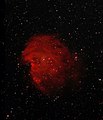NGC 2174
| Emission nebula | |
|---|---|
| H II region | |
 Monkey Head Nebula in Narrowband Sulfur-Hydrogen Alpha- Oxygen with a 1000mm telescope | |
| Observation data: J2000 epoch | |
| Right ascension | 06h 09.7m [1] |
| Declination | +20° 30′[1] |
| Distance | 6,400[citation needed] ly (2,000 pc) |
| Apparent magnitude (V) | 6.8[citation needed] |
| Apparent dimensions (V) | 40′[citation needed] |
| Constellation | Orion |
NGC 2174 (also known as Monkey Head Nebula) is an H II[1] emission nebula located in the constellation Orion and is associated with the open star cluster NGC 2175.[1] It was discovered on 6 February 1877 by French astronomer Édouard Stephan.[2] It is thought to be located about 6,400 light-years away from Earth. The nebula may have formed through hierarchical collapse.[3]
There is some equivocation in the use of the identifiers NGC 2174 and NGC 2175. These may apply to the entire nebula, to its brightest knot, or to the star cluster it includes. Burnham's Celestial Handbook lists the entire nebula as 2174/2175 and does not mention the star cluster.[4] The NGC Project (working from the original descriptive notes) assigns NGC 2174 to the prominent knot at J2000 06h 09m 23.7s, +20° 39′ 34″ and NGC 2175 to the entire nebula, and by extension to the star cluster.[5] SIMBAD uses NGC 2174 for the nebula and NGC 2175 for the star cluster.[1] [6]
Glowing gas and dark dust do not survive well in the Monkey Head Nebula. Young stars near the center of the nebula generate stellar winds and high energy radiation that causes the nebula's material to shift into complex shapes.[7] The nebula is primarily composed of hydrogen which glows at infrared wavelengths due to the radiation.[8]
Hubble 24th Anniversary Images (2014)

Gallery
- Infrared image of NGC 2174 as viewed by the Spitzer Space Telescope
- Monkey Head Nebula in Narrowband Sulfur-Hydrogen Alpha- Oxygen with a 1000mm telescope
- Monkey Head Nebula in hydrogen alpha focal length 384mm
- Monkey Head Nebula in bi-color with a 384mm telescope
- Monkeyhead nebula taken with a 140mm refractor by amateur astronomer Mark Johnston
- NGC 2174 (Monkey Head Nebula) in SHO palette by W4SM, 17" PlaneWave CDK scope, Louisa, VA
See also
References
- ^ a b c d e "NGC 2174". SIMBAD. Centre de données astronomiques de Strasbourg. Retrieved 13 July 2011.
- ^ Seligman, Courtney. "New General Catalogue Objects: NGC 2174". Celestial Atlas. Retrieved 27 August 2024.
- ^ Cotera, A.; Hester, J.; Healy, K.; Snider, K.; et al. (August 2006). Using Spitzer IRAC observations to Compare Modes of Star Formation in G305.35+0.7 and NGC 2174/5. Triggered Star Formation in a Turbulent ISM, International Astronomical Union Symposium. Prague, Czech Republic (published 2006). Bibcode:2006IAUS..237E..98C. S237, #98.[dead link]
- ^ Robert Burnham, Jr, Burnham's Celestial Handbook, Dover, 1978, p. 1280.
- ^ "Public Database". NGC/IC Project. Results for NGC 2174 and NGC 2175. Archived from the original on 28 May 2009. Retrieved 12 January 2014.
- ^ "SIMBAD Astronomical Database". Results for NGC 2175. Retrieved 13 January 2014.
- ^ "Monkey See, Monkey Do". Astronomy. 42: 10. 4 August 2014.
- ^ "Pillars in the Monkey Head Nebula". 17 March 2014.
- ^ "Hubble Celebrates 24th Anniversary with Infrared Image of Nearby Star Factory". 17 March 2014.






